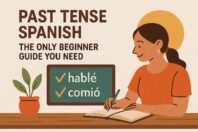Intro To Spanish Direct And Indirect Object Pronouns

Get our free email course, Shortcut to Conversational.
Have conversations faster, understand people when they speak fast, and other tested tips to learn faster.
More infoLearning how to use Spanish Direct and Indirect Object Pronouns is essential to graduating from sounding like a 5-year old, to a more competent Spanish speaker.
In this post, we will cover the difference between both types of pronouns, how you can start using them and where they are placed in a sentence.
Let’s start with a couple of basic definitions.
When we say object pronoun, we refer to a word that replaces an object in a sentence.
In English, it’s likely that you use direct and indirect object pronouns every day.
Without these pronouns, you would be forced to repeat a lot of information – which would result in clunky, child-like conversation.
For example, here is an imaginary conversation in a world without direct and indirect object pronouns:
- Dad: Do you like this shirt?
- Mom: Yes, I love that shirt
- Dad: I bought this shirt for our son
- Dad: Do you think our son is going to like this shirt?
- Mom: Yes, I think our son is going to love this shirt
Yikes.
That conversation was painful.
Now, the same conversation – but with object pronouns:
- Dad: Do you like this shirt?
- Mom: Yes, I love it
- Dad: I bought it for our son
- Dad: Do you think he is gonna like it?
- Mom: Yes, he is gonna love it
As you can see, objects pronouns help us have a more natural flowing conversation.
Now, it’s time to outline the difference between direct and indirect object pronouns in Spanish.
What Is A Direct Object Pronoun?
In a sentence, the object that receives the action of the verb is known as the direct object.
If the direct object is an animate object (person or animal), then you can easily identify the direct object pronoun by looking at the noun that follows “a” or “al”.
Let’s see some examples:
- I’m calling my parents – Estoy llamando a mis padres
- She is feeding her son – Ella está alimentando a su hijo
Now, with the correct direct object pronouns:
- I’m calling them – Estoy llamándolos
- She’s feeding him – Ella está alimentandolo
However, the direct object may not always be that obvious – especially when it doesn’t involve an animate object.
In general, an easy way to find the direct object is simply by asking who or what is receiving the action of the verb.
This will typically be the noun that immediately follows the action verb.
For example:
- I read the book every night before going to bed – Yo leo el libro cada noche antes de ir a la cama
The above example doesn’t include an animate object.
However, the main action is “to read” and so you can ask the verb: what do you read?
The answer is obviously “the book” and so that is the direct object that we need to replace with a direct object pronoun.
- I read it every night before going to bed – Lo leo cada noche antes de ir a la cama
Let review two more examples of sentences which don’t include animate objects.
- I can’t remember the house – No puedo recordar la casa
- You have to write the letter – Tu tienes que escribir la carta
Now using direct object pronouns:
- I can’t remember it – No puedo recordarla
- You have to write it – Tienes que escribirla
Spanish Direct Objects Pronouns
Let’s take a look at how direct object pronouns work with every personal pronoun.
| Personal Pronoun | Direct Object | English |
| Yo | Me | Me |
| Tú | Te | You |
| Usted | Lo / La | You (formal) |
| Él / Ella | Lo / La | Him / Her / It |
| Nosotros | Nos | Us |
| Ustedes | Los / Las | You |
| Ellos / Ellas | Los / Las | Them |
Examples Of Direct Object Pronouns Being Used
- They help me with my work – Ellos me ayudan con mi trabajo
- Ana remembers you with love – Ana te recuerda con cariño
- I respect you – Yo lo respeto
- We call him – Nosotros lo llamamos
- You wait for her – Ustedes la esperan
- I like to sing it – Me gusta cantarla
- She wants to read it – Ella quiere leerlo / Ella lo quiere leer
- My dad can take us to the movies – Mi papá nos puede llevar al cine
- We like to invite you – Nosotros los queremos invitar
- Mi sister and I can pick you (plural) up – Mi hermana y yo las podemos recoger
- We can wear them – Nosotros los podemos usar
- Can we give them away? – Las podemos regalar?
Now, it’s time to see exactly how indirect object pronouns work.

Unsure what to learn next?
Download the exact curriculum that thousands of BaseLang students have used to become fluent in Spanish.
Download Guide Now!
What Is A Indirect Object Pronoun?
Before we continue, it’s important to review the difference between direct and indirect object pronouns.
- Direct Object: Who or what is receiving the action of the verb
- Indirect Object: Whom or to whom some action is being done for
Question time.
Can you find the direct and indirect object pronouns in the below sentence?
- I wash the car for my uncle – Yo lavo el carro para mi tío
Got it?
Ok, we won’t keep you in suspense.
The who/what receiving the action of the verb (to wash) is the car ie. the direct object
The whom/to whom the action is being for is my uncle ie. the indirect object
Now, the same sentence with indirect object pronouns applied:
- I wash the car for him – Yo le lavo el carro
Spanish Indirect Object Pronouns
Let’s take a look at how indirect object pronouns work with every personal pronoun.
| Personal Pronoun | Indirect Object | English |
| Yo | Me | Me |
| Tú | Te | You |
| Usted | Le | You (formal) |
| Él / Ella | Le | Him / Her |
| Nosotros | Nos | Us |
| Ustedes | Les | You |
| Ellos / Ellas | Les | Them |
Examples Of Indirect Object Pronouns Being Used
- Can you make dinner for me? – Me puedes hacer la cena?
- My mom saves you some food in the fridge – Mi mamá te guarda algo de comida en el refrigerador
- My song wants to sing you a song – Mi hijo le quiere cantar una canción
- He always buys her flowers – Él siempre le compra flores
- She brings sweets for him – Ella le trae dulces
- Our friends bring us beers – Nuestros amigos nos traen cervezas
- I can call you a cab – Puedo llamarles un taxi / Les puedo llamar un taxi
- I read them a book – Yo les leo un libro
Using Direct and Indirect Pronouns In the Same Sentence
You will often find direct and indirect object pronouns used in the same sentence.
As a rule, the indirect object pronoun is always placed before the direct object pronoun.
Let’s see an example of this:
- I buy it for you – Yo te lo compro
- He buy it for us – Él nos lo compra
- They buy it for me – Ellos me lo compran
There is a second rule that you must remember when direct and indirect object pronouns are used in the same sentence.
When both the indirect and direct pronouns begin with the letter “l”, you must change the indirect pronoun (which comes first) to “se.”
In other words, the indirect pronouns “le” and “les” will always change to “se” when accompanied in the same sentence by direct pronouns “lo”, “las“, “los“or “las”.
This change its due to phonetic reasons.
Let’s see some examples:
- He buys the toy for his daughter – Él compra el juguete para su hija
In this sentence, the direct object is: the toy
The indirect object is: his daughter
- He buys it for her – Él le lo compra
The above sentence contains two pronouns beginning with “l”, so you must change the first pronoun “le” to “se”
- He buys it for her – Él se lo compra
Examples:
- They can bring the homework for my brother – Ellos pueden traer la tarea para mi hermano
- They can bring it for him – Ellos se la pueden traer / Ellos pueden traersela
- We are teaching the lesson to the students – Nosotros estamos enseñando la lección a los estudiantes
- We are teaching it to them – Nosotros se la estamos enseñando / Nosotros estamos enseñándosela
- I can cook the dinner for you tonight – Yo puedo cocinar la cena para ti esta noche
- I can cook it for you tonight – Yo te la puedo cocinar esta noche / Yo puedo cocinártela esta noche
Spanish Direct And Indirect Object Pronouns: Practice
1. Identify the direct object in the following sentences.
- Quiero jugar el videojuego nuevo
- Los arquitectos construyen el edificio
- El niño come las manzanas todas las mañanas
- Tu compras la camisa en la tienda
- Los estudiantes están haciendo la tarea
2. Identify the indirect object in the following sentences.
- Estoy comprando un vestido para mi madre
- Estoy leyendo el cuento a mis sobrinos
- Pueden ayudarnos a Carlos y a mi con el trabajo?
- Ella canta una canción para mi
- Nosotros llevamos la comida para ti
3. Replace the direct object with the right pronoun in the following sentences.
- Puedes bañar al perro?
- Ellas están comiendo las hamburguesas
- Los niños quieren ver la película
- Los gatos comen el atún
- Nosotros vendemos el carro
4. In the following sentences, replace only the indirect object with right objective pronoun.
- José escribe una carta para sus padres
- Podemos buscar las bebidas para los jugadores de fútbol
- Yo necesito cocinar las hamburguesas para ustedes
- Tú estás haciendo el trabajo para tu jefe
- Estoy preparando un jugo para mi tía
5. Replace both direct and indirect objects in the following sentences, use “se” if it’s necessary.
- Tú tienes que enseñar el baile a tus estudiantes.
- María lava la ropa a su abuela
- Mi tío arregla el carro para nosotros
- Ella puede comprarles a ti y a tu amigo los boletos para el cine
- Yo puedo pagar la cuenta por ti
Answers
1. Identify the direct object in the following sentences.
- Quiero jugar el videojuego nuevo
- Los arquitectos construyen el edificio
- El niño come las manzanas todas las mañanas
- Tu compras la camisa en la tienda
- Los estudiantes están haciendo la tarea
2. Identify the indirect object in the following sentences.
- Estoy comprando un vestido para mi madre
- Estoy leyendo el cuento a mis sobrinos
- Pueden ayudarnos a Carlos y a mi con el trabajo?
- Ella canta una canción para mi
- Nosotros llevamos la comida para ti
3. Replace the direct object with the right objective pronoun in the following sentences.
- Puedes bañar al perro? – Lo puedes bañar? / Puedes bañarlo?
- Ellas están comiendo las hamburguesas – Ellas las están comiendo / Ellas están comiéndolas
- Los niños quieren ver la película – Los niños la quieren ver / Los niños quieren verla
- Los gatos comen el atún – Los gatos lo comen
- Nosotros vendemos el carro – Nosotros lo vendemos
4. In the following sentences, replace only the indirect object with right objective pronoun.
- José escribe una carta para sus padres – José les escribe una carta
- Podemos buscar las bebidas para los jugadores de fútbol – Podemos buscarles las bebidas / Les podemos buscar las bebidas
- Yo necesito cocinar las hamburguesas para ustedes – Yo necesito cocinarles las hamburguesas / Yo les necesito cocinar las hamburguesas
- Tú estás haciendo el trabajo para tu jefe – Tú estás haciéndole el trabajo / Tú le estás haciendo el trabajo
- Estoy preparando un jugo para mi tía – Estoy preparándole un jugo / Le estoy preparando un jugo
5. Replace both direct and indirect objects in the following sentences, use “se” if it’s necessary.
- Tú tienes que enseñar el baile a tus estudiantes – Tú tienes que enseñárselo / Tú se lo tienes que enseñar
- María lava la ropa a su abuela – María se la lava
- Mi tío arregla el carro para nosotros – Mi tío Nos lo arregla
- Ella puede comprarles a ti y a tu amigo los boletos para el cine – Ella se los puede comprar / Ella puede comprarselos
- Yo puedo pagar la cuenta por ti – Yo te la puedo pagar / Yo puedo pagártela
______________
Make sure to read our seperate, more detailed posts on both object pronouns below:


